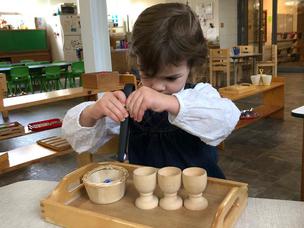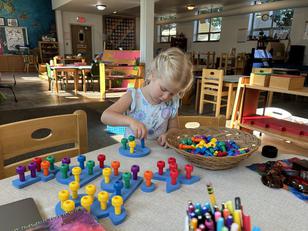Children's Center Montessori
1536 Minnehaha Ave W. St. Paul, MN 55104
7:30 a.m. to 5:00 p.m.
651-645-6053
Interested in learning more about us?
Philosophy
The goal of early childhood education should not be to fill the child with facts from a pre-selected course of studies, but rather to cultivate the child’s own natural desire to learn.
In the classroom this objective is approached in two ways: first, by allowing each child to experience the excitement of learning by his or her own choice rather than be being forced; and second, by helping the child to perfect all the natural tools for learning so that his or her ability will be at a maximum in future learning situations.
The use of the materials is based on the young child’s unique aptitude for learning--the “absorbent mind”, as described by Dr. Maria Montessori. In her writings she frequently compared the young mind to a sponge. It literally absorbs information from the environment. Since children retain this ability to learn by absorbing until they are almost seven years old, their experiences could be enriched by a classroom where they could handle materials which would demonstrate basic educational information to them.
The sensitive periods for early learning are vital. These are periods of intense fascination for learning a particular characteristic or skill. It is easier for children to learn a particular skill during the corresponding sensitive period than at any other time in their lives. The classroom takes advantage of this fact by allowing children freedom to select individual activities which correspond to their own interests for that particular period of time.
Basic materials are described as follows:
Practical Life Exercises
Using the child’s natural inclinations as a point of departure, we use several exercises in the classroom to help the child satisfy the need for meaningful activity. For these activities, we use familiar objects--buttons, brushes, dishes, pitchers, water, and many other things which the child recognizes from home experiences.
For young children there is something special about tasks which an adult may consider ordinary--washing dishes, paring vegetables, pouring, measuring, sorting, polishing or cleaning. We provide these activities which are important to them, but are often unavailable.
Although the Practical Life Exercises may seem simple and commonplace, they are actually a very important part of the program. The children learn to pay attention to details as they follow a regular sequence of actions. Good working habits are learned as each task is finished and put away before another is begun. Each task helps to perfect their coordination so that they will be able to work later with the more intricate academic materials. No learning takes place without concentration and attention. Children prepare to learn by performing exercises which help them to gradually lengthen the time in which they can focus attention a specific activity.
Sensorial Materials
Since children quite naturally use all of their powers of observation during the early years, we feel that this is an ideal time to give children equipment which would sharpen their senses and enable them to understand the many impressions they receive through them.
Each of the Sensorial Materials isolates one defining quality such as color, weight, shape, texture, size, sound, smell, etc. The equipment emphasizes this one particular quality by elimination or minimizing other differences.
The Sensorial materials help the children to distinguish, to categorize, and to relate new information to what is already known. This process is described as the beginning us knowledge. It is brought about by the intelligence working in a concentrated way on the impressions given by the senses.
Learning to Write
To be able to write, children must develop a two-fold skill. They must commit to memory the shapes of the letters and their corresponding sounds, and must develop the muscular skill necessary for using a pencil with control.
The materials are designed to offer children the opportunity to learn the shapes and sounds of the letters in a way that is completely independent from perfecting motor skills. Children learn to write not by writing, but by performing a number of purposefully structured activities which prepare them both indirectly and directly for facility in handwriting.
The child is introduced to the alphabetical symbols by using sandpaper letters. Each letter is outlined in sandpaper on an individual card, the vowels on blue and the consonants on pink. The teacher shows the child how to trace the letter with two fingers following the same direction in which the symbol is normally written.
The children learn phonetic sounds of the letters before learning the alphabetical names in sequence. The phonetic sounds are given first because these are the sounds heard when pronouncing words. For example, the child can hear the “t” at the beginning of a word like “top”, but cannot hear the alphabetical sound “tee”. This approach lends itself well to word building, reading and spelling. It is important that parents be aware of this method of teaching in the classroom so that they may assist their children at home if the child is anxious for this kind of help.
Several activities in the classroom have as their purpose the skill of learning to control a pencil. One such activity is filling in outlines--an activity which does not weary the child because it is enjoyable. To make the outline, equipment known as the Metal Insets are used. Each inset represents a different geometric shape. After selecting a figure and tracing it on paper, the child fills in the outline with a colored pencil. At first the strokes are erratic and may extend beyond the outline. By degrees they become more accurate and uniform. Working with the Metal Insets is not considered creative art initially, although often very purposeful and intricate designs result after the pencil control skill has been mastered.
After working with the Metal Insets and the Sandpaper Letters, a day comes when the child realizes that he or she is able to make words with a pencil. When writing begins in this spontaneous way, the child is spared many tedious hours of forced effort. Writing is fun.
From Writing to Reading
After the Sandpaper Letters are learned, the child is ready to make words with the Moveable Alphabet. The teacher arranges a box of objects representing three letter words with short vowel sounds. Picture cards of words given verbally may also be used to provide variety or to emphasize particular letter sounds. Very slowly the child sounds out the word to be built and chooses the corresponding letters from the box. This activity is usually continued over a period of time.
Reading very naturally follows the word building exercises. The child gradually realizes that he or she can read back the words built. Pronouncing these words is considered a pre-reading exercise in the sense that reading implies the understanding of words which someone else has constructed. The opportunity to take this step comes when the child matches a set of objects or pictures with a set of cards on which the names are already written. Handmade worksheets and small booklets supplement these materials.
Small reading boxes are provided which isolate words by vowel sounds. Picture cards and a set of matching word cards for phonetic three-letter words are used first, and four and five-letter words follow. The third set of boxes contains isolated phonograms to allow the child to practice the irregularities of words for both reading and spelling.
Reading and writing skills do not necessarily progress simultaneously; some children learn to read at three or four, others at five and some at six. Similarly, writing skills may become efficient at an early age or at a later date. One skill is not dependent upon the other, and actual age is not as important as the right moment of readiness. If a child is forced to wait until the important initial period of interest has passed, then he or she will miss that opportunity when propelled by natural enthusiasm. The freedom of the classroom allows each child’s own interests to determine the progress in a non-competitive and encouraging environment.
Mathematics
If a child has access to mathematical equipment in the early years, he or she can easily and joyfully assimilate many facts and skills of arithmetic. On the other hand, these same facts and skills may require long hours of drudgery and drill if they are introduced later in abstract form only.
Our materials are designed to represent all types of quantities; the child who becomes interested in counting likes to touch or move the items as he counts them. A child not only sees the symbol for 1, 1000, or ½, but can also hold each of these quantities.
Later, by combining the equipment, separating it, sharing it, counting it, and comparing it, the basic operations of arithmetic are demonstrated. Material for the operations of addition, subtraction, division and multiplication demonstrate in a concrete form, and lend themselves to a better understanding of these operations in an abstract form. These activities give the satisfaction of learning by discovery, provide the confidence of understanding, and a love of math.
Science
The pre-school years are ideal for the introduction of science. Characteristics of this age period lend themselves well to developing observational skills: natural curiosity and attention to detail enable children to enjoy learning by discovery via experimentation or special studies. A foundation is being laid as a base for future learning.
Biology, zoology, archeology, geology, botany, astronomy, physics and chemistry are introduced in a step-by-step manner, beginning with vocabulary building and identification skills using a variety of classroom materials: matching games, collections, equipment to assemble or demonstrate or for experimentation, books, drawings and illustrations, and objects for study. Through individual or group lessons, bits of information are added gradually, the subtleties and complexities absorbed each in turn until more advanced concepts and principles are understood. This understanding eventually leads to skill in abstract reasoning, comparing, contrasting, and the ability to draw conclusions from a given set of facts.
In addition to basic classroom materials and introductory lessons, special emphasis is given to a variety of specific studies each year. These studies are chosen carefully, based upon the interests of the child, to offer variety, to expand upon studies introduced in the year prior, or to introduce current or pertinent discoveries, for example.
Classroom activities and formal group lessons are integrated and are of equal importance. Classroom materials encourage self-discovery, the development of special interests, presentation on an individual basis, spontaneous small group activities, and follow-ups to previous lessons. Most are designed for a hands-on approach to naming, sorting, classifying, experimenting or researching.
Formal group lessons are particularly conducive to providing regular sequential sessions in science. Children are usually divided into two groups, with background and experience a deciding factor rather than age. Because some children spend three or four years with us, we continue to develop new lessons and expand upon earlier lessons. Some lessons which are introductory to new children, make excellent review for a second year child and add clarity or further understanding.
History, Geography and Cultural Studies
As with the sciences, history, geography and cultural studies progress from simple to complex becoming more integrated as children master basic information or ideas. Classroom materials such as land forms, globes, world or continent puzzle maps give opportunities for recognition or identification, a sense of each geographical entity’s place within the world.
Again, group and individual classroom lessons are coordinated. As each child progresses, physical and political geography and the study of the major eco-zones of the world are integrated with the study of specific peoples and their ways of life and histories. Strong attention is given to understanding the world as a whole: its water cycle, rock cycles, continental drifts, mountain building, weather patterns, and other related materials.
The goal is not so much to memorize data, but to encourage awareness, understanding and appreciation of history, geography and cultures around the world. It is the fascination with the subject, a love of learning, that will enable a child to be much more receptive in this and future learning situations.
Other activities, such as group singing, music appreciation, creative art, theater and drama, crafts, a second language, grammar, poetry, games, are all coordinated with the above programs according to the interests of the children.
We hope to offer as many opportunities as possible for young children to expand their knowledge during the years when they are motivated by spontaneous interest. Many materials are designed and hand-made by the teaching staff, to reflect the interests of both children and teachers and the level of work for which the children are ready.



